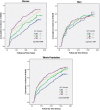Sex-Specific Associations of Serum Alkaline Phosphatase With Metabolic Syndrome and Its Components: Over 15 Years of Follow-Up Among Iranian Adults
- PMID: 40698749
- PMCID: PMC12329340
- DOI: 10.1002/jcla.70075
Sex-Specific Associations of Serum Alkaline Phosphatase With Metabolic Syndrome and Its Components: Over 15 Years of Follow-Up Among Iranian Adults
Abstract
Background: To investigate the association of serum alkaline phosphatase (ALP) with incident metabolic syndrome (MetS) and its components, as well as the influence of sex on this relationship among Iranian adults.
Methods: The multivariable Cox proportional hazards regression models were applied to assess the associations between ALP both as continuous and categorical variables with incident MetS and its components.
Results: Among 831 subjects (467 women) with a mean age of 44.51 years, during a median follow-up of 15.6 years, 597 MetS cases (336 women) occurred. Interaction was found between ALP quartiles and sex (p-value = 0.006). Among women, increasing levels of ALP across the second to fourth quartiles were associated with hazard ratios (HRs) of 1.269, 1.491, and 2.092 for MetS, respectively (p for trend < 0.001). Among men, no association was found between ALP and incident MetS. Among women, the second and fourth quartiles of ALP were associated with incident high triglycerides (TG), with HRs of 1.793 and 1.815, respectively. Moreover, a 1-SD increase in ALP conferred a 17.9% higher risk of low high-density lipoprotein cholesterol (HDL-C). Among men, a 1-SD increase in ALP was associated with an HR of 1.222 for incident high waist circumference (WC) (All p-values < 0.05).
Conclusion: Sex significantly influenced the impact of serum ALP on the incidence of MetS and its components. In women, ALP was a strong harbinger for incident MetS and its dyslipidemia components. However, among men, the increasing value of ALP was associated with incident central obesity but not MetS.
Keywords: alkaline phosphatase; components; metabolic syndrome; sex differences.
© 2025 The Author(s). Journal of Clinical Laboratory Analysis published by Wiley Periodicals LLC.
Conflict of interest statement
The authors declare no conflicts of interest.
Figures



Similar articles
-
Gender differences in the impact of 3-year status changes of metabolic syndrome and its components on incident type 2 diabetes mellitus: a decade of follow-up in the Tehran Lipid and Glucose Study.Front Endocrinol (Lausanne). 2023 May 25;14:1164771. doi: 10.3389/fendo.2023.1164771. eCollection 2023. Front Endocrinol (Lausanne). 2023. PMID: 37305040 Free PMC article.
-
[Association Between Surrogate Markers of Insulin Resistance and Incident Cardiovascular Disease in a Population With Stages 0-3 Cardiovascular-Kidney-Metabolic Syndrome: A Prospective Cohort Study].Sichuan Da Xue Xue Bao Yi Xue Ban. 2025 Mar 20;56(2):495-505. doi: 10.12182/20250360503. Sichuan Da Xue Xue Bao Yi Xue Ban. 2025. PMID: 40599269 Free PMC article. Chinese.
-
Plasma Hepatic Transaminases and Incidence of Metabolic Syndrome Before Midlife in Military Adults: A CHIEF Cohort Study.Endocr Metab Immune Disord Drug Targets. 2025;25(7):582-592. doi: 10.2174/0118715303326392241022050205. Endocr Metab Immune Disord Drug Targets. 2025. PMID: 39806968
-
Home treatment for mental health problems: a systematic review.Health Technol Assess. 2001;5(15):1-139. doi: 10.3310/hta5150. Health Technol Assess. 2001. PMID: 11532236
-
Sertindole for schizophrenia.Cochrane Database Syst Rev. 2005 Jul 20;2005(3):CD001715. doi: 10.1002/14651858.CD001715.pub2. Cochrane Database Syst Rev. 2005. PMID: 16034864 Free PMC article.
References
-
- Reaven G. M. and Chen Y. D., “Role of Insulin in Regulation of Lipoprotein Metabolism in Diabetes,” Diabetes/Metabolism Reviews 4, no. 7 (1988): 639–652. - PubMed
-
- Cameron A. J., Shaw J. E., and Zimmet P. Z., “The Metabolic Syndrome: Prevalence in Worldwide Populations,” Endocrinology and Metabolism Clinics 33, no. 2 (2004): 351–375. - PubMed
-
- Ansarimoghaddam A., Adineh H. A., Zareban I., Iranpour S., HosseinZadeh A., and Kh F., “Prevalence of Metabolic Syndrome in Middle‐East Countries: Meta‐Analysis of Cross‐Sectional Studies,” Diabetes & Metabolic Syndrome 12, no. 2 (2018): 195–201. - PubMed
MeSH terms
Substances
LinkOut - more resources
Full Text Sources
Medical
Miscellaneous

